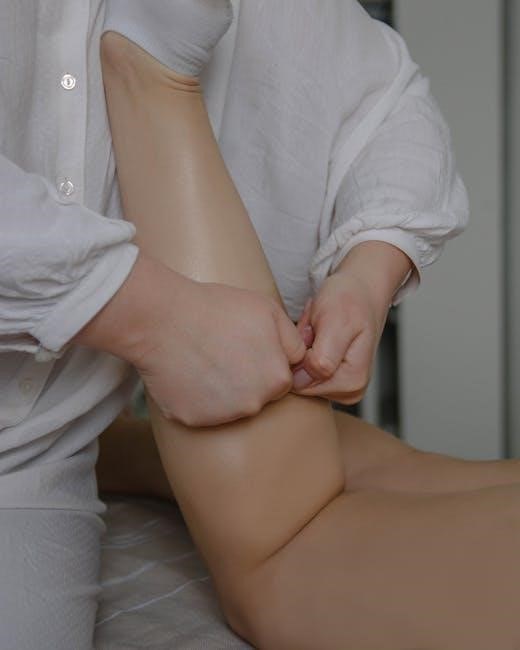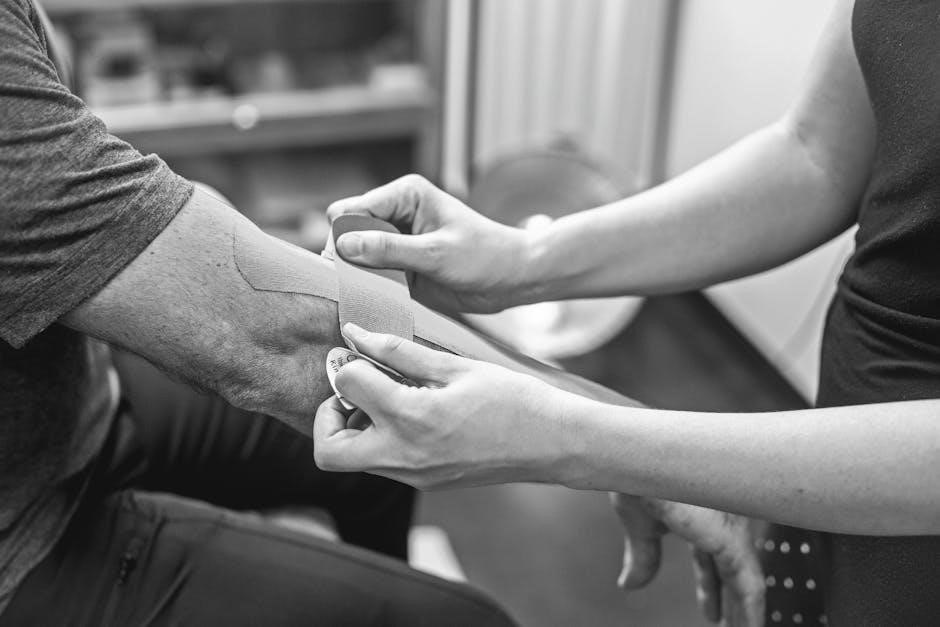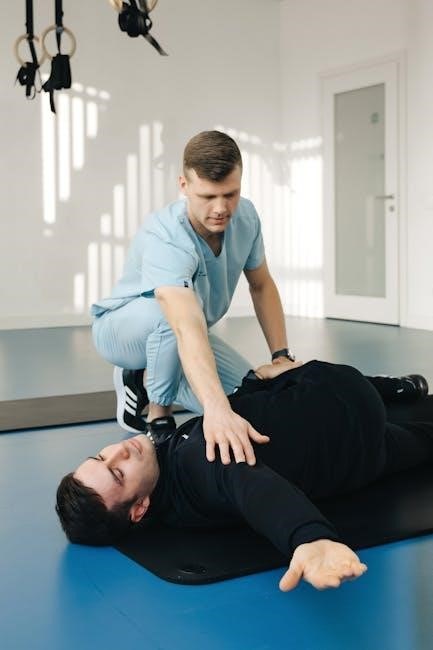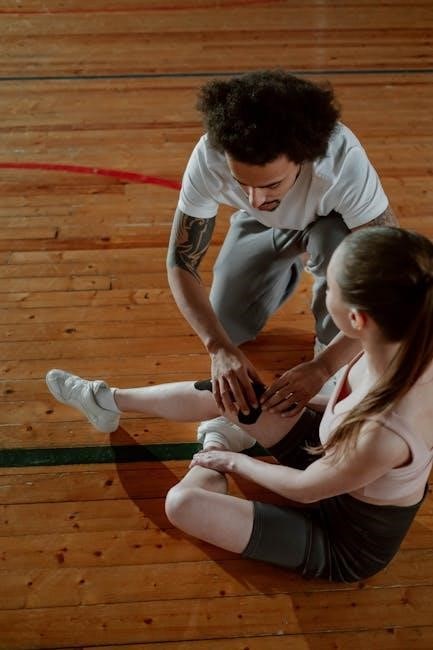The sacroiliac (SI) joint connects the sacrum and ilium bones, playing a crucial role in supporting the spine and withstanding body weight. SI joint pain often manifests as lower back pain, radiating to the buttocks or thighs, and can range from sharp discomfort to a dull ache. It may worsen with activities like sitting, lifting, or bending. Common causes include trauma, repetitive stress, or degenerative conditions, leading to inflammation or instability in the joint. Understanding this condition is essential for effective management and relief through targeted exercises and therapies.
1.1 What is the SI Joint?
The sacroiliac (SI) joint is a synovial joint located at the base of the spine, connecting the sacrum (a triangular bone at the bottom of the spine) to the ilium (the largest bone of the pelvis). It plays a vital role in supporting the upper body’s weight and facilitating movement between the spine and the legs. The SI joint is designed to absorb shock, reduce friction, and allow for controlled movement during activities like walking, bending, and twisting. While it is not as mobile as other joints, it is essential for maintaining proper posture and enabling functional mobility. Its unique structure, supported by strong ligaments, makes it both stable and adaptable to various physical demands.
1.2 Understanding SI Joint Pain and Its Causes
SI joint pain arises from inflammation or instability in the sacroiliac joint, often due to trauma, repetitive stress, or degenerative conditions. Activities like bending or lifting can exacerbate discomfort, leading to pain in the lower back, buttocks, or thighs. Hypermobility or limited mobility in the joint may cause wear and tear, resulting in inflammation. Factors such as poor posture, muscle imbalances, or prior injuries can also contribute to SI joint dysfunction. Identifying the root cause is crucial for effective management, as tailored exercises and therapies can help restore joint stability and alleviate symptoms effectively.

Benefits of Exercises for SI Joint Pain
Exercises for SI joint pain stabilize the joint, improve mobility, and strengthen surrounding muscles, reducing discomfort and enhancing overall lower back stability and function naturally.
2.1 How Exercise Helps in Reducing SI Joint Pain
Exercise plays a vital role in alleviating SI joint pain by strengthening the surrounding muscles, improving joint stability, and reducing stress on the sacroiliac joint. Regular movement helps maintain proper alignment and prevents hypermobility or stiffness. Gentle stretches and core-strengthening exercises can enhance flexibility and mobility while minimizing inflammation. Low-impact activities, such as pelvic tilts or bridging, target the muscles around the SI joint, providing relief and promoting long-term joint health. Consistency in these exercises can significantly reduce pain and improve overall function, making daily activities more manageable.
2.2 Importance of Strengthening and Stretching
Strengthening the muscles around the SI joint is crucial for stability and pain relief. Weakness in the core, glutes, or lower back can lead to poor posture and joint strain. Stretching, on the other hand, improves flexibility and reduces stiffness, allowing for better movement and reducing muscle tension. Together, strengthening and stretching help restore proper joint mechanics, alleviate inflammation, and prevent further injury. Regular practice can enhance posture, reduce muscle spasms, and promote long-term joint health, making daily activities more comfortable. These exercises are fundamental for managing SI joint pain effectively and maintaining overall spinal alignment and function.

Best Exercises for SI Joint Pain Relief
Effective exercises for SI joint pain relief include:
- Pelvic Tilts
- Bridging Exercises
- Knee to Chest Stretch
- Cat-Cow Stretch
- Bird Dog Exercise
- Pigeon Pose
- Superman Stretch
- Side-Lying Leg Lifts
3.1 Pelvic Tilts

Pelvic tilts are a gentle and effective exercise for alleviating SI joint pain. Lie on your back with knees bent and feet flat on the floor. Engage your core and gently tilt your pelvis upward, flattening your lower back against the floor. Hold for 5 seconds, then release. Repeat for 10-15 repetitions. This movement helps improve joint mobility and reduce stiffness. It strengthens the surrounding muscles, providing stability to the SI joint. Regular practice can significantly reduce pain and discomfort, making it an excellent starting point for those with SI joint issues. Perform slowly and avoid forcing the movement to maximize benefits. Ideal for daily routines, pelvic tilts promote long-term relief and improved posture.
3.2 Bridging Exercises
Bridging exercises are an excellent way to strengthen the muscles around the SI joint, improving stability and reducing pain. To perform a bridge, lie on your back with knees bent and feet flat on the floor. Slowly lift your hips toward the ceiling, squeezing your glutes and lower back muscles as you rise. Hold the position for 5-10 seconds before lowering back down. Aim for 10-15 repetitions. This exercise targets the glutes and hamstrings, which play a key role in supporting the SI joint. Proper form is essential to avoid strain, so focus on a controlled movement and avoid arching your back excessively. Regular bridging can help stabilize the pelvis and alleviate SI joint discomfort effectively.

3.3 Knee to Chest Stretch
The Knee to Chest Stretch is an effective exercise for alleviating SI joint pain by targeting the muscles around the lower back and hips. To perform this stretch, lie on your back with your knees bent and feet flat on the floor. Slowly bring one knee toward your chest while keeping the other leg relaxed. Hold this position for 20-30 seconds, then gently lower your leg back down. Repeat on the other side. This exercise helps reduce muscle tension, improves flexibility, and promotes proper SI joint alignment. Regular practice can significantly enhance comfort and mobility for those experiencing SI joint discomfort.
3.4 Cat-Cow Stretch
The Cat-Cow Stretch is a gentle, flowing exercise that promotes flexibility and eases tension in the spine and sacroiliac joint. Start on your hands and knees, keeping your spine neutral. Inhale as you arch your back, lifting your head and tailbone (Cow Pose). Exhale as you round your spine, tucking your chin and pelvis (Cat Pose). Repeat for 10-15 repetitions. This exercise gently mobilizes the SI joint, improving joint mobility and reducing stiffness. It also strengthens the muscles around the spine, providing additional support. Perform slowly and avoid forcing beyond a comfortable range to prevent discomfort. Regular practice can help alleviate SI joint pain and improve overall spinal health.
3.5 Bird Dog Exercise

The Bird Dog Exercise is an effective core-strengthening activity that enhances spinal stability and promotes balance, making it ideal for alleviating SI joint pain. To perform this exercise, start on your hands and knees in a tabletop position. Engage your core muscles by drawing your belly button toward your spine. Slowly extend your right arm forward and your left leg backward, holding for a few seconds before returning to the starting position. Alternate sides and repeat for 8-12 repetitions on each side. This exercise improves balance, strengthens the muscles around the SI joint, and enhances posture without putting excessive strain on the joint itself.
3.6 Pigeon Pose

Pigeon Pose is a yoga-based exercise that targets the hips and lower back, offering relief from SI joint pain. Start on your hands and knees, then bring one knee forward, placing your ankle near the opposite knee. Extend the other leg behind you, keeping your spine straight. Lower your torso gently toward the ground, stretching the back hip and glutes. Hold for 20-30 seconds and switch sides. This pose improves flexibility, reduces tightness, and alleviates pressure on the SI joint. Modify the stretch by placing a cushion under your hip for comfort. Breathe deeply to enhance relaxation and avoid bouncing or forcing the stretch.
3.7 Superman Stretch
The Superman Stretch is an effective exercise for alleviating SI joint pain by strengthening the muscles in the lower back and hips. To perform this stretch, lie face down on a flat surface with arms extended overhead and legs straight. Slowly lift your arms, shoulders, and legs off the ground, keeping your neck neutral and engaging your core. Hold the position for 5-10 seconds before lowering back down. This exercise targets the erector spinae muscles, improving posture and reducing strain on the SI joint. Regular practice can enhance spinal stability and provide relief from discomfort. Perform 3 sets of 10 repetitions for optimal results.

3.8 Side-Lying Leg Lifts
Side-lying leg lifts are an effective exercise for alleviating SI joint pain by strengthening the hip abductors and improving pelvic stability. To perform this exercise, lie on your side with your legs straight and feet touching. Slowly lift the top leg away from the bottom leg, keeping it straight, and hold for 2-3 seconds before lowering it back down. Avoid arching your back or using momentum. Start with 10-15 repetitions on each side and gradually increase as strength improves. This exercise helps stabilize the SI joint and reduces discomfort by enhancing muscle support around the pelvis.

Creating a Workout Routine for SI Joint Pain
A structured routine with 2-3 sessions weekly, focusing on 10-15 minute durations, can alleviate SI joint pain. Incorporate gentle stretches, strengthening exercises, and gradual progression for optimal results.
4.1 Sample Workout Schedule
A well-structured workout schedule for SI joint pain relief might include 3-4 sessions per week. Begin with gentle exercises like pelvic tilts and bridging to strengthen the core and improve flexibility. Dedicate 2 days to strengthening exercises such as bird dog and superman stretches, focusing on controlled movements. Incorporate stretching exercises like cat-cow and pigeon pose on alternate days to enhance mobility. Rest or engage in low-impact activities like swimming or yoga on non-workout days. Gradually increase intensity as comfort allows, ensuring proper form to avoid aggravation. Consistency is key for long-term relief and joint stability.
4.2 Tips for Consistency and Progression
Consistency is key to managing SI joint pain effectively. Start with short sessions and gradually increase duration as tolerance improves. Warm up before exercises to enhance flexibility and reduce stiffness. Focus on proper form to avoid exacerbating the condition. Incorporate low-impact activities like swimming or cycling for additional support. Progress slowly by introducing more challenging exercises over time. Use supportive gear, such as braces, if recommended by a healthcare professional. Track progress in a journal to stay motivated and identify patterns. Finally, consult with a physical therapist or chiropractor to tailor exercises to your specific needs and ensure long-term improvement.

Preventing SI Joint Pain Through Exercise
Regular exercise helps stabilize the SI joint, improve posture, and strengthen core and surrounding muscles, reducing the risk of pain and discomfort over time.
5.1 Posture Correction Exercises
Posture correction exercises are vital for managing SI joint pain, as poor alignment can strain the joint. Simple stretches like chest opens and neck releases improve spinal alignment. Strengthening core muscles through planks or pelvic tilts helps stabilize the pelvis. Standing tall with shoulders back and weight evenly distributed reduces pressure on the SI joint. Regular practice of these exercises can prevent long-term discomfort and promote proper movement patterns. Consistency is key to maintaining optimal posture and alleviating SI joint-related issues effectively.
5.2 Core Strengthening to Support the SI Joint
Strengthening the core muscles is essential for stabilizing the SI joint and alleviating pain. Exercises like planks, bird dog, and bridges target the abdominals and lower back, providing a solid foundation for joint stability. A strong core reduces strain on the SI joint during daily activities, minimizing discomfort. Incorporating these exercises into a routine can enhance posture and balance, further protecting the joint from unnecessary stress. It’s important to start slowly and focus on proper form to avoid overexertion. Over time, consistent core strengthening can significantly reduce SI joint pain and improve overall mobility. These exercises are often recommended in PDF guides for SI joint pain relief, emphasizing their effectiveness in long-term management.
6.1 Final Thoughts on Managing SI Joint Pain
Managing SI joint pain requires a holistic approach, combining targeted exercises, lifestyle adjustments, and professional guidance. Consistency in performing exercises like pelvic tilts, bridging, and cat-cow stretches can significantly alleviate discomfort. Strengthening the core and improving posture are equally vital for long-term relief. Downloading a comprehensive SI joint pain exercises PDF can provide a structured plan, ensuring you follow proven techniques. While exercises are effective, they may not completely eliminate pain, so consulting a chiropractor or physical therapist is advisable for personalized care. Patience and persistence are key, as healing and strengthening take time. By adhering to a well-rounded routine and seeking expert advice, you can achieve lasting relief and restore mobility.

